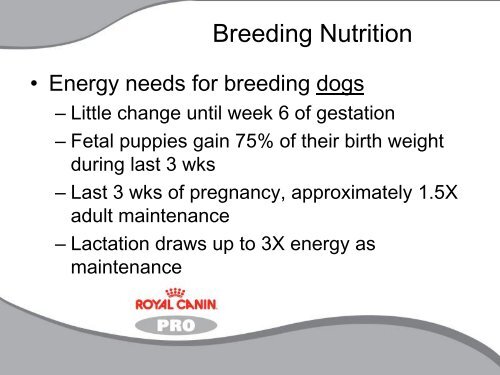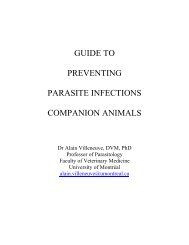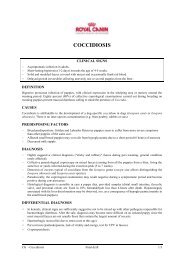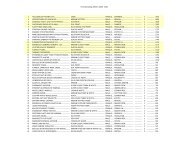Breeding Nutrition.pdf - Royal Canin Canada
Breeding Nutrition.pdf - Royal Canin Canada
Breeding Nutrition.pdf - Royal Canin Canada
You also want an ePaper? Increase the reach of your titles
YUMPU automatically turns print PDFs into web optimized ePapers that Google loves.
<strong>Breeding</strong> <strong>Nutrition</strong><br />
• Energy needs for breeding dogs<br />
– Little change until week 6 of gestation<br />
– Fetal puppies gain 75% of their birth weight<br />
during last 3 wks<br />
– Last 3 wks of pregnancy, approximately 1.5X<br />
adult maintenance<br />
– Lactation draws up to 3X energy as<br />
maintenance
• <strong>Nutrition</strong>al needs of lactation<br />
<strong>Breeding</strong> <strong>Nutrition</strong><br />
– By weeks 3 and 4, maximum nutritional needs<br />
– Number of nursing offspring directly influences<br />
nutritional needs<br />
– Lactation needs takes priority over the needs of the<br />
dam
• Energy needs for<br />
breeding cats<br />
– From heat and<br />
breeding, increased<br />
energy needs<br />
– Lactation period is<br />
longer in cats than<br />
dogs, prolonged<br />
weaning<br />
<strong>Breeding</strong> <strong>Nutrition</strong>
• Reproductive nutrients<br />
<strong>Breeding</strong> <strong>Nutrition</strong><br />
– Energy through fat and carbohydrates<br />
• Dogs<br />
• Cats<br />
– Last 3 weeks of pregnancy higher needs<br />
– First 4 weeks of lactation significantly higher needs<br />
– From time of breeding through gestation, higher needs<br />
– Lactation for 6 weeks, higher
• Carbohydrates<br />
<strong>Breeding</strong> <strong>Nutrition</strong><br />
– Carbohydrates are a key energy source<br />
through glucose<br />
– During gestation/lactation glucose is needed<br />
for fetal development and lactose synthesis<br />
– Glucose directly impacts mothering, as<br />
hypoglycemic bitches are lethargic and do not<br />
encourage their pups to nurse.
• Carbohydrates<br />
<strong>Breeding</strong> <strong>Nutrition</strong><br />
– Low carbohydrate diets negatively influence survival<br />
of puppies (Romos, 1981)<br />
• Statistically significant increased numbers of stillbirths<br />
• Statistically significant increased neonatal mortality within<br />
first 3 days<br />
• This is attributed to the hypoglycemic state of the dam<br />
– Anorexia in the dam is also seen when fed low<br />
carbohydrate diets<br />
– Ketosis can result
• Reproductive<br />
nutrients<br />
– Increased protein<br />
• Fetal growth (organ<br />
development)<br />
• Neonatal growth<br />
(musculoskeletal)<br />
• Mammary tissue<br />
development<br />
• Milk production<br />
<strong>Breeding</strong> <strong>Nutrition</strong>
• Reproductive nutrients<br />
– Folic Acid (folate)<br />
• Behavioral changes in estrous<br />
• Follicular growth<br />
• Fertilization<br />
<strong>Breeding</strong> <strong>Nutrition</strong><br />
• DNA replication in embryo and fetal cell division<br />
• Helps prevent cleft palate, spina bifida and other birth<br />
defects
<strong>Breeding</strong> <strong>Nutrition</strong><br />
• Reproductive nutrients<br />
– DHA<br />
• Embryo development<br />
• Growth of fetus<br />
– Major structural component of the retina<br />
– Major structural component of brain tissue<br />
– Β-Carotene<br />
• Promotes estrogen<br />
– Synthesis of sexual pheromones<br />
– Development of uterine endometrium<br />
• Progesterone synthesis<br />
– Prepares uterus for implantation of embryos<br />
– Ensures maintenance of gestation
• Reproductive nutrients<br />
– Tyrosine<br />
<strong>Breeding</strong> <strong>Nutrition</strong><br />
• Precursor of neurotransmitters<br />
• Sexual behavior<br />
• Estrous<br />
– More visible bleeding, better timing of breeding<br />
– Greater acceptance of males<br />
• Follicular growth<br />
• Ovulation
<strong>Breeding</strong> <strong>Nutrition</strong><br />
• Reproductive nutrients<br />
– Vitamin C<br />
• Accumulates in ovarian tissues<br />
• AOX to protect oocytes and assist fertilization<br />
• Plays a role in DNA replication<br />
– Vitamin E<br />
• Ovulation<br />
• AOX<br />
• Spermatogenesis<br />
• Plays a role in DNA replication
• Reproductive nutrients<br />
– Vitamin A<br />
<strong>Breeding</strong> <strong>Nutrition</strong><br />
• Maintains integrity of reproductive tissues<br />
• Promotes maturation of follicles<br />
– Biotin<br />
• Changes in the uterus to enhance pregnancy<br />
• Assists in ovulation<br />
– Taurine<br />
• Fertilization
• Reproductive nutrients<br />
– Arginine<br />
• Ovulation<br />
• Fertilization<br />
– Minerals (Cu, Zn, Mn)<br />
• Sexual cycle<br />
• Follicular growth<br />
• Ovulation<br />
• Fertilization<br />
<strong>Breeding</strong> <strong>Nutrition</strong>
<strong>Breeding</strong> <strong>Nutrition</strong><br />
• <strong>Nutrition</strong> of puppies and kittens<br />
Milk ME<br />
kcal/ml<br />
Protein<br />
g/l<br />
Fat<br />
g/l<br />
Ca++<br />
g/l<br />
Phos<br />
g/l<br />
Dog 1.5 75 95 2.4 1.8<br />
Cow 0.6 33 36 1.2 1.6<br />
Cat 1.2 75 85 1.8 1.6
• Β-Carotene<br />
• Arginine<br />
• Taurine<br />
• EPA and DHA<br />
• Copper<br />
• Zinc<br />
<strong>Breeding</strong> <strong>Nutrition</strong><br />
Optimal Growth, Immunologic Support<br />
• Iron<br />
• Selenium and Vit E<br />
• Vitamin C<br />
• Vitamin A<br />
• B vitamin complex<br />
• FOS
<strong>Breeding</strong> <strong>Nutrition</strong><br />
• Key nutrients for optimal growth<br />
– GI stability<br />
• FOS – feeds the intestinal epithelial cells<br />
• MOS – moves the “bad” bacteria out<br />
– Neurological development<br />
• EPA<br />
• DHA
<strong>Breeding</strong> <strong>Nutrition</strong><br />
• Key nutrients for optimal growth<br />
– Musculoskeletal development<br />
• Protein<br />
• Macrominerals<br />
• Microminerals<br />
• Vitamins<br />
• Controlled energy for controlled growth
• Eclampsia<br />
<strong>Breeding</strong> <strong>Nutrition</strong><br />
– Imbalance in calcium dynamics<br />
– Calcium levels in the body are controlled by<br />
hormones, intestinal absorption and kidney<br />
excretion<br />
– If calcium is over-supplemented during<br />
pregnancy the dam’s physiological wiring will<br />
be short-circuited
• Eclampsia<br />
<strong>Breeding</strong> <strong>Nutrition</strong><br />
– Intestinal absorption of high dietary calcium<br />
supercedes the need to reserve calcium from<br />
excretion through the kidneys, and/or to<br />
access calcium reserves in the skeletal tissue<br />
through hormonal activity<br />
– As a result, the dam loses the ability to<br />
respond quickly to fluctuations in calcium<br />
reserves and demand
• Eclampsia<br />
<strong>Breeding</strong> <strong>Nutrition</strong><br />
– Calcium is a key nutrient in muscle<br />
contraction<br />
– Immediate deficiency results in muscle<br />
tremors, severe weakness, and cardiac<br />
arrhythmias<br />
– Can be life-threatening<br />
– This is an emergency
• Eclampsia<br />
<strong>Breeding</strong> <strong>Nutrition</strong><br />
– In the case of a bitch that has a history of<br />
eclampsia, it is recommended to supplement<br />
calcium under the guidance of a veterinarian,<br />
along with Vitamin D, the last 2 weeks of<br />
gestation and through lactation.<br />
– This is one of the exceptions to the mantra<br />
“Do not supplement.”
<strong>Breeding</strong> <strong>Nutrition</strong><br />
• Maternal behavior affected by nutrition<br />
– Hypoglycemia leads to lethargy and<br />
inattention<br />
– Influence of hypocalcemia on maternal<br />
cannibalism of neonates.<br />
• Borderline hypocalcemia can impact behavior<br />
before, or without, any signs of eclampsia<br />
• To help diagnose, serum ionized calcium levels<br />
are used (not protein bound calcium as is the<br />
norm)







